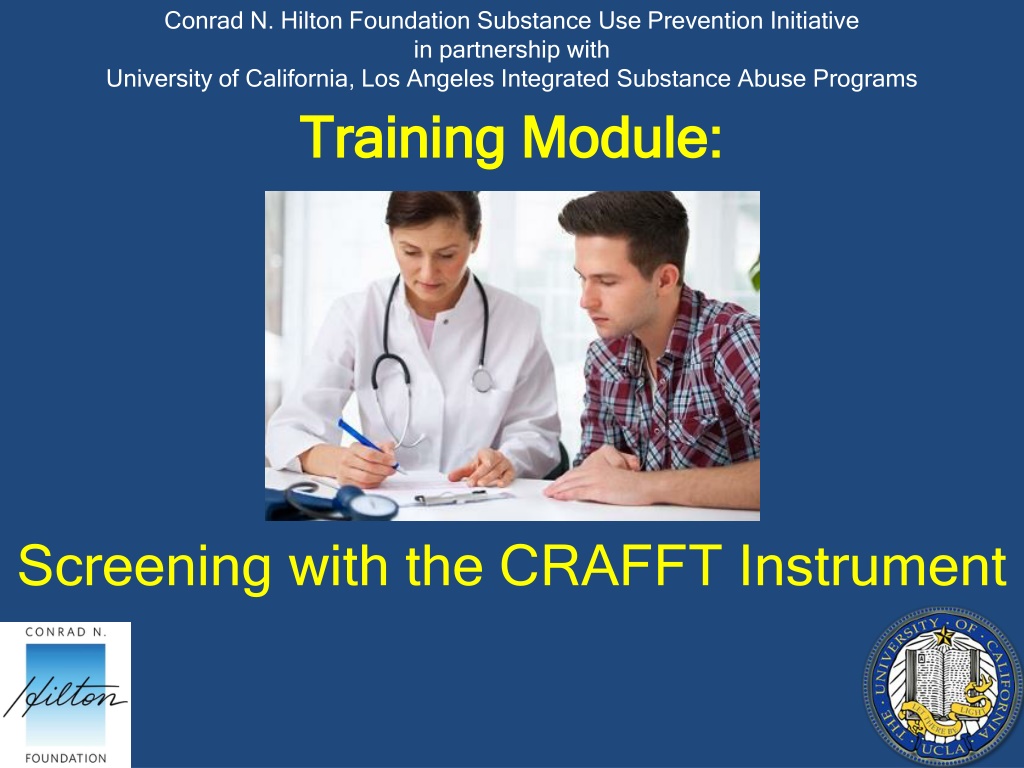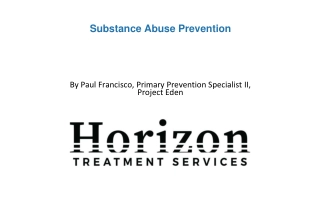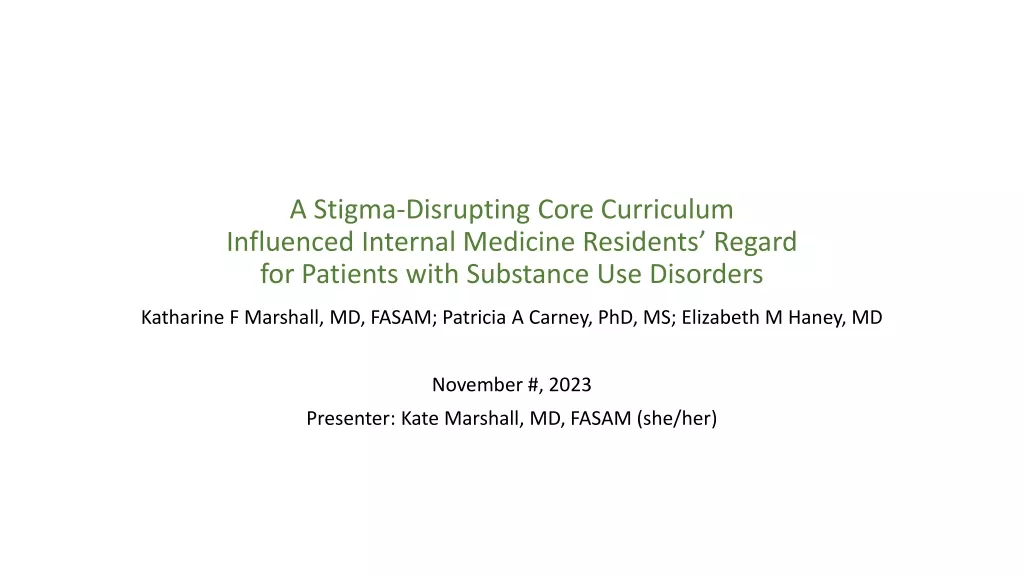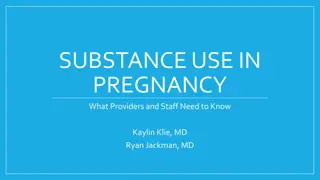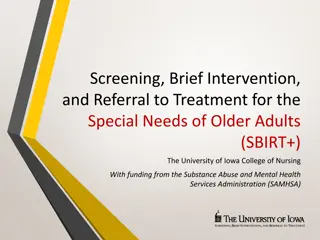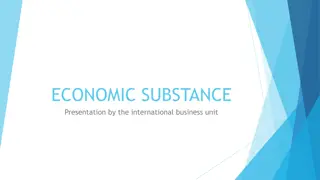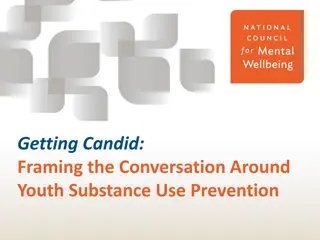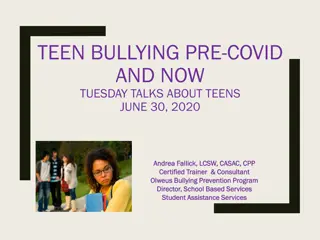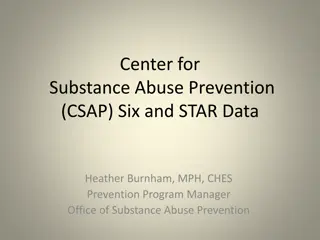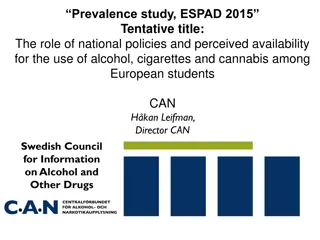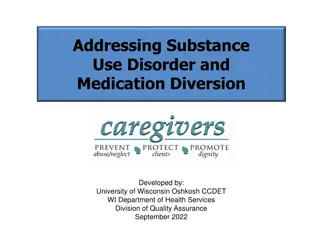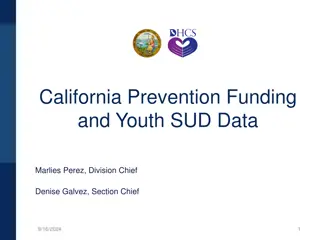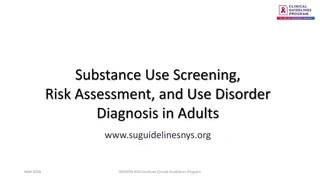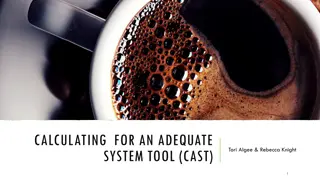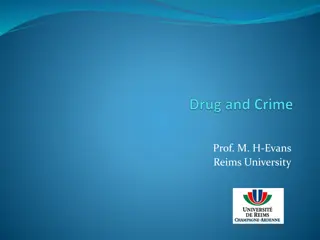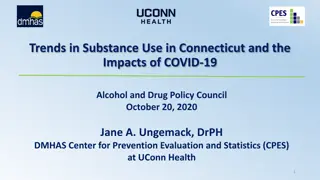Substance Use Prevention Training Module
This content provides insights into the Conrad N. Hilton Foundation Substance Use Prevention Initiative in partnership with UCLA Integrated Substance Abuse Programs. It covers training objectives, SBIRT approach, what SBIRT can accomplish, assessment, characteristics of a good screening tool, and details about the CRAFFT screening tool. Participants will learn how to confidently address substance use, administer the CRAFFT tool, interpret results, and more.
Download Presentation

Please find below an Image/Link to download the presentation.
The content on the website is provided AS IS for your information and personal use only. It may not be sold, licensed, or shared on other websites without obtaining consent from the author.If you encounter any issues during the download, it is possible that the publisher has removed the file from their server.
You are allowed to download the files provided on this website for personal or commercial use, subject to the condition that they are used lawfully. All files are the property of their respective owners.
The content on the website is provided AS IS for your information and personal use only. It may not be sold, licensed, or shared on other websites without obtaining consent from the author.
E N D
Presentation Transcript
Conrad N. Hilton Foundation Substance Use Prevention Initiative in partnership with University of California, Los Angeles Integrated Substance Abuse Programs Training Module: Training Module: Screening with the CRAFFT Instrument
Training Objectives Training Objectives By the end of this training module, participants will be able to: 1. Confidently bring up the subject of substance use with the adolescents they serve. 2. Administer the CRAFFT screening tool 3. Understand how to interpret CRAFFT score results 2
SBIRT: SBIRT: A Population Approach to A Population Approach to Prevention/Early Intervention Prevention/Early Intervention Screening a population to identify individuals who are using substances in a risky or unhealthy way Brief Intervention to change behaviors and attitudes of individuals who are putting their health at risk with substance use. Sometimes this is one intervention, sometimes a few sessions Referral to Treatment for individuals who require specialty care (behavioral, pharmacological treatments) 3
What SBIRT Can Accomplish What SBIRT Can Accomplish Identify adolescents with SUD and link them with specialty care (about 5% of adolescents) Severe Substantial Educate adolescents who are using substances (approx 11.5% using alcohol, 9.4% using drugs) motivate behavior change) Moderate Mild None 4
Whats going on in these What s going on in these pictures? pictures? Assessment Assessment Screening Screening 5
Characteristics of a Characteristics of a Good Screening Tool Good Screening Tool Brief (10 or fewer questions) Flexible Easy to administer and take Addresses alcohol and drugs Indicates need for further assessment or intervention Has good sensitivity and specificity 6
Screening Tool: CRAFFT Screening Tool: CRAFFT Developed by researchers at the Center for Adolescent Substance Abuse Research at Boston Children s Hospital Specifically designed for individuals under 21 Between 4 and 9 questions depending on responses Useful to determine if further conversation (brief intervention) about substance use is warranted Available at http://www.ceasar-boston.org/CRAFFT/index.php Available in 13 languages, can be self-administered (may be preferable) 7
Introducing the CRAFFT Introducing the CRAFFT Provide a gentle introduction to talking about substance use Communicate that some questions are personal, and that the information is confidential Adolescents may be surprised you are asking about substance use. Be straight-forward and explain the screening is part of routine for everyone, and that you will use this information so that you can provide the best possible care Emphasize that you will not disclose to a parent unless there is extreme risk 8
Screening Tool: CRAFFT Screening Tool: CRAFFT Full instrument and scoring available at http://www.integration.samhsa.gov/clinical- practice/sbirt/CRAFFT_Screening_interview.pdf Starts with three pre-screening questions: 1. In the past 12 months, did you drink any alcohol (more than a few sips)? 2. In the past 12 months, did you smoke* any marijuana or hashish? 3. In the past 12 months, did you use anything else to get high? 9
Screening Tool: CRAFFT Screening Tool: CRAFFT Then the six CRAFFT questions: 1. Have you ever ridden in a CAR driven by someone (including yourself) who was high or had been using alcohol/drugs? 2. Do you ever use alcohol or drugs to RELAX, feel better about yourself, or fit in? 3. Do you ever use alcohol or drugs when you are by yourself or ALONE? 10
Screening Tool: CRAFFT Screening Tool: CRAFFT 4. Do you ever FORGET things you did while using alcohol or drugs? 5. Do your FAMILY or FRIENDS tell you that you should cut down on your drinking or drugs use? 6. Have you ever gotten into TROUBLE while you were using alcohol or drugs? 11
How To Administer the CRAFFT How To Administer the CRAFFT THREE INTRODUCTION PRE-SCREENING QUESTIONS If NO TO ALL pre-screening questions, only ask CAR question If YES TO ANY pre-screening questions, ask six CRAFFT questions 12
How to Interpret CRAFFT Scores How to Interpret CRAFFT Scores Each YES on the 6 CRAFFT questions scores 1 point If only yes to car question, educate on risks of drunk/drugged driving A score of 1 or higher (on questions other than the car question) is a positive screen, indicating need for additional assessment/intervention The higher the CRAFFT score, the more likely the individual has serious problems related to substance use 13
Cases of Acute Danger Very high-risk behaviors you identify may require something more immediate than SBIRT Taking unknown pills Mixing sedatives Intravenous use Engaging in potentially dangerous activities while impaired Use leading to an ER visit or arrest Refer for or conduct suicide/safety evaluation if necessary Refer for or conduct emergency mental health evaluation if necessary 14
Cases of Acute Danger: What You Can Say Because I am so worried I have to share some of this information with your parents and arrange an appointment for you to speak with my colleague who has a lot of experience talking to kids about drug use. In the meantime, can you promise me that you will not use any alcohol, pills, or drugs at all before your next appointment? What do you think would be the best way to share this information with your parents? 15
CRAFFT Role Play 1. Take the blank CRAFFT screener from your packet. One person will be the provider giving the assessment, the other will be the adolescent. 2. CLINICIANS: Introduce the CRAFFT and ask the questions. 3. ADOLESCENTS: Be a real-life adolescent you have encountered. And don t be the most difficult adolescent ever! 16
CRAFFT Role Play: How Did It Go? 1.How did this compare to the way you usually discuss substance use with adolescents? 2.Were there any aspects of the screening process you found particularly challenging? 3.Do you have any concerns about doing this with the adolescents you work with? 17
Questions? Comments? Questions? Comments? 18
